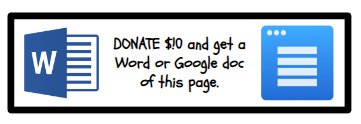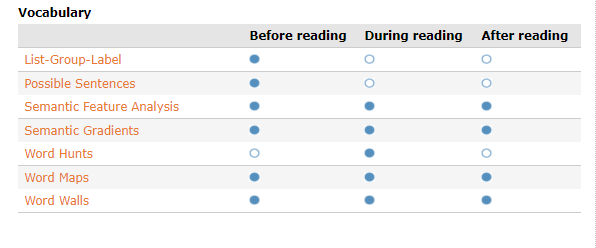


Teaching Vocabulary
Vocabulary is essential to comprehension. To understand texts, students must apply strategies before, during, and after reading.
Here are all the words, by grade, students should know in the various content areas. The list was compiled by Data Works and comprise the Marzano list, and the Dolch and Fry words. WORDS TO KNOW BY GRADE LEVEL.
Marzano’s 6-Step Process for Teaching Vocabulary
Step 1: Explain: The teacher will give a kid-friendly description, explanation, or example of the new word.
Step 2: Restate: The teacher will ask the students to describe, explain, or give examples in their own words.
Step 3: Show: The teacher will ask the students to draw and write a picture, symbol, or word representation.
Step 4: Discuss: The teacher and the students will have vocabulary discussions.
Step 5: Refine and Reflect: The students will go back and discuss the words with a peer while making the necessary changes to their prior knowledge.
Step 6: Apply in Learning Games: The students will participate in vocabulary games using content-specific words.
Creative Ideas to Reinforce Vocabulary
- Think-aloud Modeling
- Word Collection
- Mystery Match
- Dictionary Detectives
- Word Riddles
- Repeated Application
- Word Sorts
- Real or Make-Believe?

Best Practices for Vocabulary
- Failure Free Online
- PAVE Procedure

ELL VOCABULARY: As Kinsella (2005) tells us, many English learners (ELs) lack sufficient academic language to complete complex academic tasks in both their home language and English. Beck, McKeown, and Kucan (2008) have taught us to think about the words we select for rich instruction and how we can explain their meanings in powerful ways. Furthermore, English-language development (ELD) lessons must be based on structured language practice that matches students’ English-language proficiency levels (Sonoma County Office of Education, 2006). Backward planning (Wiggins & McTighe, 2005) is the first step in successfully infusing ELD instruction into core curricula. Analyze the lesson, including questions and tasks in sidebars and assessments, to determine the concepts students are expected to learn based on state standards and the necessary comprehension strategies. Our students won’t learn academic vocabulary solely by listening to us; they must practice using it themselves (Kinsella, 2005). Structured language practice provides opportunities for students to orally practice using academic language to express language functions (see Sonoma County Office of Education, 2006, for more details).
Sentence Frames: Think about the language function students need to think, talk, and write about the core concept. Description, cause/ effect, persuasion, inference, and making judgments are necessary to comprehend information. To develop sentence frames, write sentences that express the target language function (e.g., compare/contrast), then replace target vocabulary with blanks. Finally, create a word bank or list the words eliminated from the original sentences. The resulting materials are sentence frames with fill-in spaces appropriate for different language levels and a word bank. Lower-level structures are less complex than higher-level frames. To develop sentence frames, group students of similar language levels together in pairs, present frames that match their language levels on sentence strips, and provide a word bank of the target vocabulary words. Support students in learning to select vocabulary, insert it into the frame and read the frames aloud. Teach students the following routine: Listen to me say the sentence; now you say it with me; now say it to me; finally, tell it to your partner. After guiding students through the process several times, have them practice with each other. The activity’s primary purpose is to provide oral practice; however, it is also suitable for written practice.
ELLs are expected to use simple sentences to express the target language function of compare/contrast (e.g., two separate sentences: Oranges are sweet. Lemons are sour.). Level 3 language learners are expected to use more complex sentence structures (e.g., Oranges and lemons are both fruits, but oranges are sweet and lemons are sour.). Finally, level 4 language learners are expected to use the most complex structures (e.g., The main difference between oranges and lemons is oranges are sweet while lemons are sour). Note that students of all three language levels express the compare/contrast function; the difference is the level of complexity. Students should work with more complex language structures as they progress in their language learning.
For more on teaching ELLs, please visit my RETELL page.
![]()
